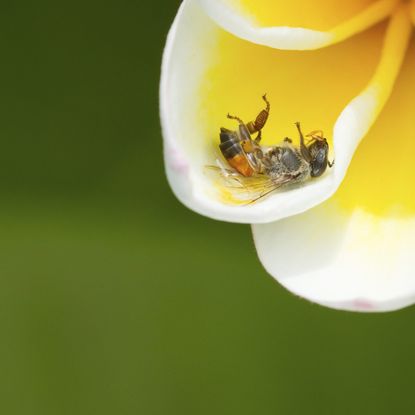What Are Neonicotinoids Pesticides And How Do Neonicotinoids Work


We’ve all heard a little something about the bird and the bees, but have you heard mention of neonicotinoids and bees? Well, hold on to your hat because this important information could mean the life and death of our precious pollinators in the garden. Keep reading to learn more about neonicotinoids killing bees and what we can do about it.
What are Neonicotinoids?
So the first question that needs to be clarified, obviously, is “what are neonicotinoids?” If you haven’t heard this term, that’s probably due to the fact that it’s a relatively new class of synthetic insecticides. Neonicotinoid pesticides (aka neonics) are similar to nicotine, which is naturally found in nightshade plants like tobacco, and supposedly less harmful to humans but is poisonous to bees and many other insects and animals. These types of insecticides affect the central nervous system of insects, resulting in paralysis and death. Among them includes:
- Imidacloprid – considered the most popular neonicotinoid, you’ll find it listed under the trade names Merit®, Admire®, Bonide, Ortho Max, and some of the Bayer Advanced products. While listed as moderately toxic, it has been found highly toxic to bees and other beneficial insects.
- Acetamiprid – even with its low acute toxicity, this one has shown population-level effects on honeybees.
- Clothianidin – this is a neurotoxic and is highly toxic to bees and other non-target insects.
- Dinotefuran – commonly used as a broad spectrum of insects infesting cotton and vegetable crops.
- Thiacloprid - although targeted to control sucking and biting insects, low doses are highly toxic to honeybees, and also causes physiological problems in fish when used within aquatic environments.
- Thiamethoxam – this systemic insecticide is absorbed and transported to all parts of the plant and while considered moderately toxic, it’s harmful to bees, aquatic, and soil organisms.
Studies have shown that residues from neonicotinoids pesticides can accumulate in the pollen of treated plants, posing a real danger to pollinators even after use of the pesticide stops on the plant.
How Do Neonicotinoids Work?
The EPA classifies neonicotinoids as both toxicity class II and class III agents. They are generally labeled with a “Warning” or “Caution.” Since the neonicotinoid pesticides block specific neurons in insects, they are deemed less harmful to warm-blooded animals but are highly toxic to insect pests as well as beneficial species like bees. Many commercial nurseries treat plants with neonicotinoid pesticides. The chemical residue left behind from these treatments remain in nectar and pollen that gets collected from the bees, which is fatal. Unfortunately, research suggests that even if you treat these plants using organic approaches once purchased, the damage is already done, as the residue is still present. Therefore, neonicotinoids killing bees is inevitable. Of course, an insecticide does not have to kill in order to have an effect. Research has indicated that exposure to neonicotinoids can interfere with honeybee reproduction and their ability to navigate and fly.
Neonicotinoids Alternatives
That being said, when it comes to neonicotinoids and bees (or other beneficials), there are options. One of the best ways to keep harmful products out of the garden is to buy only organically grown plants. You should also purchase organic seeds or start your plants, trees, etc. from cuttings which have not been exposed to any chemicals and then continue using organic approaches throughout their lifetime. Sometimes the use of pesticides becomes necessary. So when using insecticides, common sense goes a long way. Always read and follow the label directions carefully, and appropriately. Also, you might want to pay attention to the LD50 rate before you buy. This is the amount of chemical it takes to kill 50% of a test population. The smaller the number, the more toxic it is. For instance, according to one resource in the case of a honeybee, the amount of imidacloprid that must be ingested to kill 50% of the test subjects is 0.0037 micrograms compared to carbaryl (Sevin), which requires 0.14 micrograms – meaning the imidacloprid is far more toxic to bees. This is something to keep in mind before using any insecticide, including neonicotinoids. Weigh your options carefully and, if you have determined that an insecticide is still necessary, consider the least toxic options first, such as insecticidal soap or neem oil. Take into account whether or not the plant needing treatment is flowering and attractive to bees as well. If the plant is blooming, consider waiting to treat once it has finished and is less attractive to bees and other pollinating insects.
Gardening tips, videos, info and more delivered right to your inbox!
Sign up for the Gardening Know How newsletter today and receive a free download of our most popular eBook "How to Grow Delicious Tomatoes."

Nikki Tilley has been gardening for nearly three decades. The former Senior Editor and Archivist of Gardening Know How, Nikki has also authored six gardening books.
-
 26 Different Types Of Orchids – With Pictures & Information
26 Different Types Of Orchids – With Pictures & InformationDiscover stunning orchid types to grow in your home and garden – from easy beginner varieties to rare and exotic species that are the preserve of experts.
By Melanie Griffiths
-
 Urban Composting Guide: How To Compost In The Middle Of The City
Urban Composting Guide: How To Compost In The Middle Of The CityUrban composting does not have to be daunting. You can compost in the city, and maybe even try some urban worm composting!
By Mary Ellen Ellis